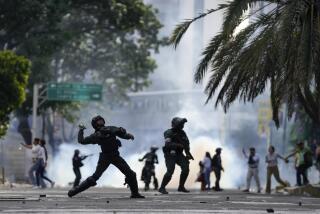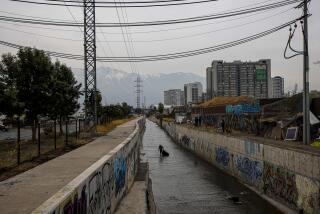Hungry, sick and increasingly desperate, thousands of Venezuelans are pouring into Colombia
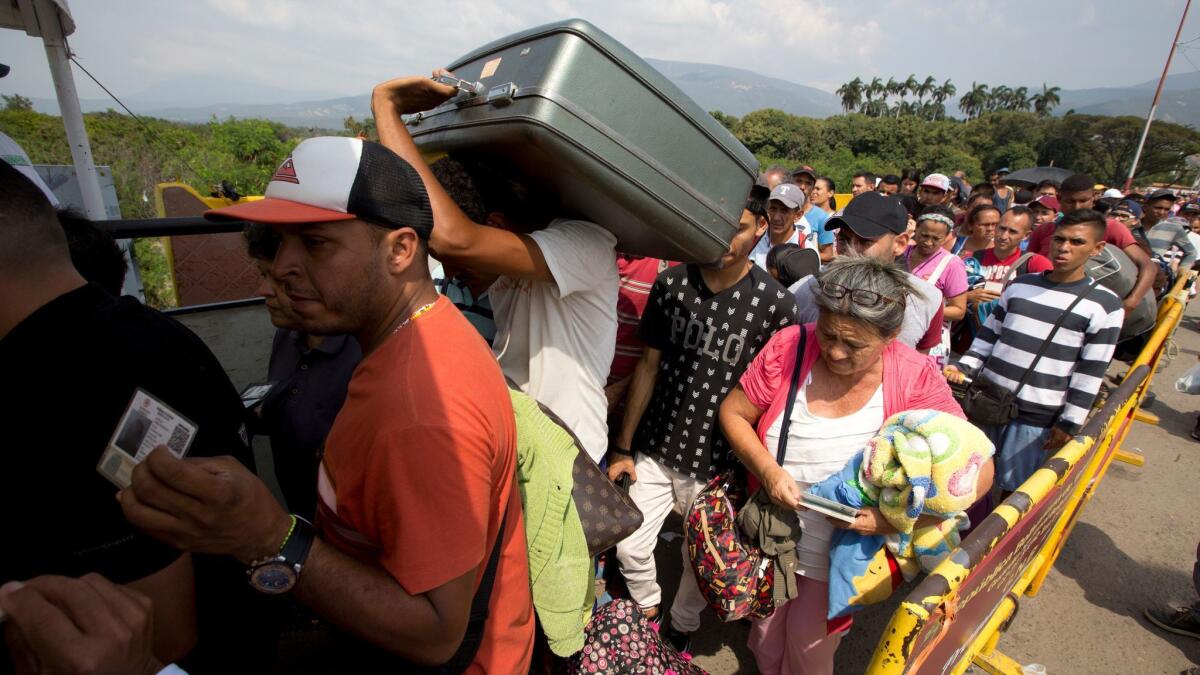
Reporting from Cucuta, Colombia â For evidence that the Venezuelan migrant crisis is overwhelming this Colombian border city, look no further than its largest hospital.
The emergency room designed to serve 75 patients is likely to be crammed with 125 or more. Typically, two-thirds are impoverished Venezuelans with broken bones, infections, trauma injuries â and no insurance and little cash.
âIâm here for medicine I take every three months or I die,â said Cesar Andrade, a 51-year-old retired army sergeant from Caracas. He had come to Cucutaâs Erasmo Meoz University Hospital for anti-malaria medication he canât get in Venezuela. âIâm starting a new life in Colombia. The crisis back home has forced me to do it.â
The huge increase in Venezuelan migrants fleeing their countryâs economic crisis, failing healthcare system and repressive government is affecting the Cucuta metropolitan area more than any other in Colombia. Itâs where 80% of all exiting Venezuelans headed for Colombia enter as foreigners.
Despite turning away Venezuelans with cancer or chronic diseases, the hospital treated 1,200 migrant emergency patients last month, up from the handful of patients, mostly traffic collision victims, in March 2015, before the Venezuelan exodus started gathering steam.
The hospitalâs red ink is rising along with its caseload. The facility has run up debts of $5 million over the last three years to accommodate Venezuelans because the Colombian government is unable to reimburse it, said Juan Agustin Ramirez, director of the 500-bed hospital.
âThe government has ordered us to attend to Venezuelan patients but is not giving us the resources to pay for them,â Ramirez said. âThe truth is, we feel abandoned. The moment could arrive when we will collapse.â
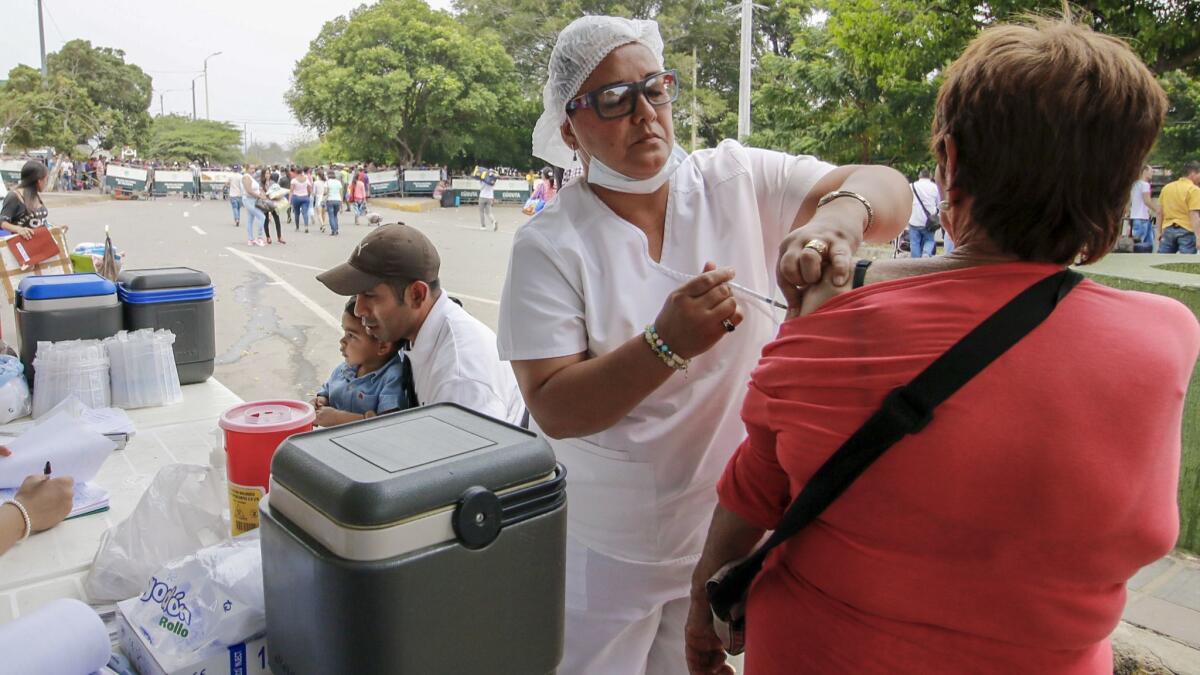
An average of 35,000 people cross the Simon Bolivar International Bridge linking the two countries every day. About half return to the Venezuelan side after making purchases, conducting business or visiting family. But the rest stay in Cucuta at least temporarily or move on to the Colombian interior or other countries.
For many Venezuelans, the first stop after crossing is the Divine Providence Cafeteria, an open-air soup kitchen a stoneâs throw from the bridge. A Roman Catholic priest, Father Leonardo Mendoza, and volunteer staff serve some 1,500 meals daily. But itâs not enough.
One recent day, lines stretched halfway around the block with Venezuelans, desperation and hunger etched on their faces. But some didnât have the tickets that were handed out earlier in the day and were turned away.
âChildren come up to me and say, âFather, Iâm hungry.â Itâs heartbreaking. Itâs the childrenâs testimony that inspires the charitable actions of all of us here,â Mendoza said.
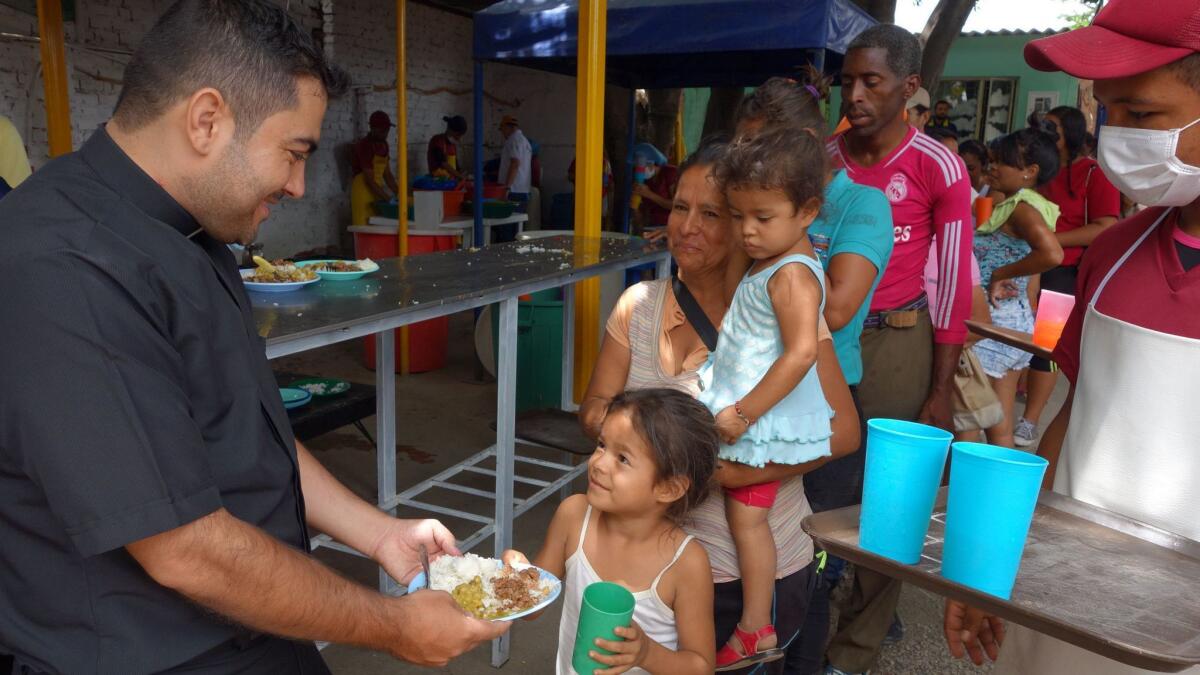
The precise number of Venezuelan migrants who are staying in Colombia is difficult to calculate because of the porousness of the 1,400-mile border, which has seven formal crossings. But estimates range as high as 800,000 arrivals over the last two years. At least 500,000 have gone on to the U.S., Spain, Brazil and other Latin American countries, officials here say.
âEvery day 40 buses each filled with 40 or more Venezuelans leave Cucuta, cross Colombia and go directly to Ecuador,â said Huber Plaza, a local delegate of the National Disasters Risk Management Agency. âThey stay there or go on to Chile, Argentina or Peru, which seems to be the preferred destination these days.â
Many arrive broke, hungry and in need of immediate medical attention. Over the last two years, North Santander province, where Cucuta is located, has vaccinated 58,000 Venezuelans for measles, diphtheria and other infectious diseases because only half of the arriving children have had the shots, said Nohora Barreto, a nurse with the provincial health department.
On the day Andrade, the retired army sergeant, sought treatment, gurneys left little space in the crowded ward and hospital corridors, creating an obstacle course for nurses and doctors who shouted orders, handed out forms and began examinations.
Andrade and many other patients stood amid the gurneys because all the chairs and beds were taken. Nearby, a pregnant woman in the early stages of labor groaned as she walked haltingly among the urgent care patients, supported by a male companion.
Dionisio Sanchez, a 20-year-old Venezuelan laborer, sat on a gurney awaiting treatment for a severe cut he suffered on his hand at a Cucuta construction site. Amid the bustle, shouting and medical staff squeezing by, he stared ahead quietly, holding his hand wrapped in gauze and resigned to a long wait.
âIâm lucky this didnât happen to me back home,â Sanchez said. âEveryone is suffering a lot there. I didnât want to leave, but hunger and other circumstances forced me to make the decision.â
Signs of stress caused by the flood of migrants are abundant elsewhere in this city of 650,000. Schools are overcrowded, charitable organizations running kitchens and shelters are overwhelmed and police who chase vagrants and illegal street vendors from public spaces are outmanned.
âWeâll clear 30 people from the park, but as soon as we leave, 60 more come to replace them,â said a helmeted policeman on night patrol with four comrades at downtownâs Santander Plaza. He expressed sympathy for the migrants and shook his head as he described the multitudes of homeless, saying it was impossible to control the tide.
Sitting on a park bench nearby was Jesus Mora, a 21-year-old mechanic who arrived from Venezuela in March. He avoids sleeping in the park, he said, and looks for an alleyway or âsomeplace in the shadows where police wonât bother me.â
âAs long as they donât think Iâm selling drugs, Iâm OK,â Mora said. âTonight, Iâm here to wait for a truck that brings around free food at this hour.â Mora said he is hoping to get a work permit. Meanwhile, he is hustling as best he can, recycling bottles, plastic and cardboard he scavenges on the street and in trash cans.
Metropolitan Cucutaâs school system is bursting at the seams with migrant kids, who are given six-month renewable passes to attend school. Eduardo Berbesi, principal of the 1,400-student Frontera Educational Institute, a public K-12 school in Villa de Rosario thatâs located a short distance from the Simon Bolivar International Bridge, says he has funds to give lunches to only 60% of his students. He blames the government for not coming through with money to finance the schoolâs 40% growth in enrollment since the crisis began in 2015.
âThe government tells us to receive the Venezuelan students but gives us nothing to pay for them,â Berbesi said.
Having to refuse lunches to hungry students bothers him. âAnd itâs me the kids and their parents blame, not the state.â
On a recent afternoon, every street corner in Cucuta seemed occupied with vendors selling bananas, candy, coffee, even rolls of aluminum foil.
âIf I sell 40 little cups of coffee, I earn enough to buy a kilo of rice and a little meat,â said Jesus Torres, 35, a Venezuelan who arrived last month. He was toting a shoulder bag of thermoses he had filled with coffee that morning to sell in plastic cups. âThe situation is complicated here but still better than in Venezuela.â
That evening, Leonardo Albornoz, 33, begged for coins at downtown stoplight as his wife and three children, ages 6 months to 8 years, looked on. He said he had been out of work in his native Merida for months but decided to leave for Colombia in April because his kids âwere going to sleep hungry every night.â
When the light turned red, Albornoz approached cars and buses stopped at the intersection to offer lollipops in exchange for handouts. About half of the drivers responded with a smile and some change. Several bus passengers passed him coins through open windows.
From the sidewalk, his 8-year-old son, Kleiver, watched despondently. It was 9:30 pm â he had school the next morning and should have been sleeping, but Albornoz and his wife said they had no one to watch him or their other kids at the abandoned building where they were staying.
âMy story is a sad one like many others, but the drop that made my glass overflow was when the [Venezuelan] government confiscated my little plot of land where we could grow things,â Albornoz said.
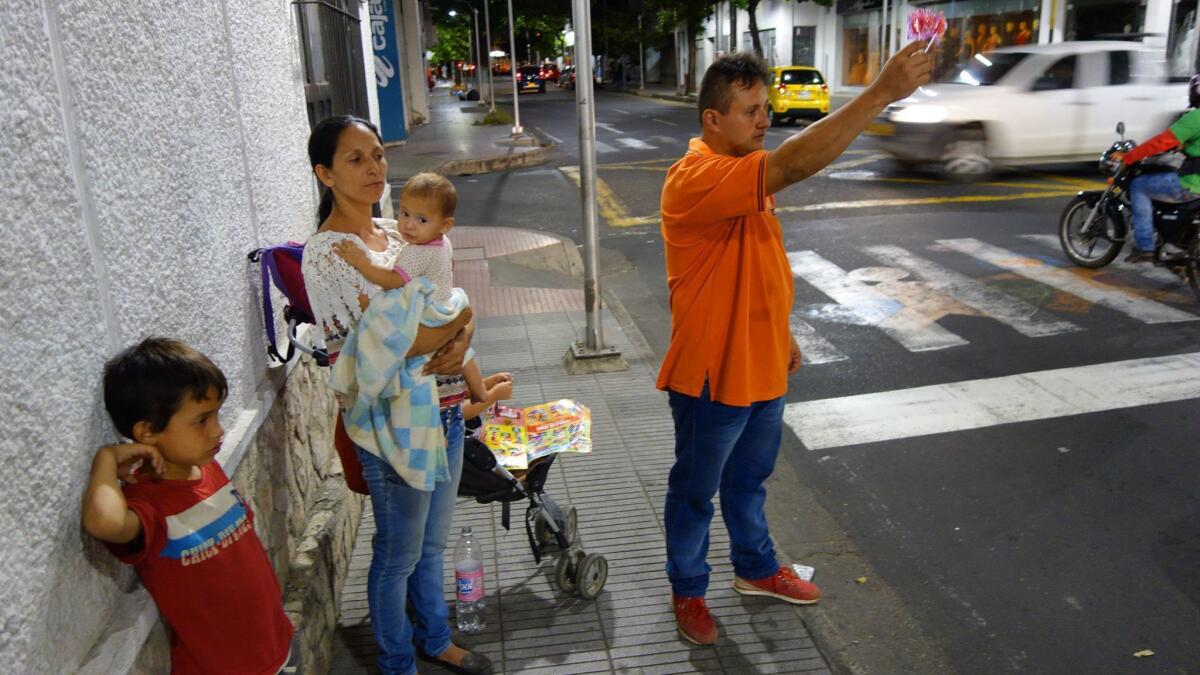
The increase in informal Venezuelan workers has pushed Cucutaâs unemployment rate to 16% compared with the 9% rate nationwide, Mayor Cesar Rojas said in an interview at City Hall. Although Colombians generally have welcomed their neighbors, he said, signs of resentment among jobless local residents is growing.
âThe national government isnât sending us the resources to settle the debts, and now we have this economic crisis,â Rojas said. âWith the situation in Venezuela worsening, the exodus can only increase.â
The Colombian government admits it has been caught off guard by the dimensions â and costs â of the Venezuelan exodus, one of the largest of its kind in recent history, said Felipe MuĂąoz, who was named Venezuelan border manager by President Juan Manuel Santos in February.
âThis is a critical, complex and massive problem,â MuĂąoz said. âNo country could have been prepared to receive the volume of migrants that we are receiving. In Latin America, itâs unheard of. Weâre dealing with 10 times more people than those who left the Middle East for Europe last year.â
In agreement is Jozef Merkx, Colombia representative of the United Nations High Commissioner for Refugees, which is taking an active role in helping Colombia deal with the influx. Central America saw large migrant flows in the 1980s, but they were caused by armed conflicts, he said.
âVenezuelans are leaving for different reasons, and the mixed nature of the displaced crisis is what makes it a unique exodus,â Merkx said during an interview in his Bogota office.
MuĂąoz said Colombia feels a special obligation to help Venezuelans in need. In past decades, when the neighboring countryâs oil-fueled economy needed more manpower than the local population could provide, hundreds of thousands of Colombians flooded in to work. Now the tables are turned.
Colombiaâs president has appealed to the international community for help. The U.S. government recently stepped up: The State Department announced Tuesday it was contributing $18.5 million âto support displaced Venezuelans in Colombia who have fled the crisis in their country.â
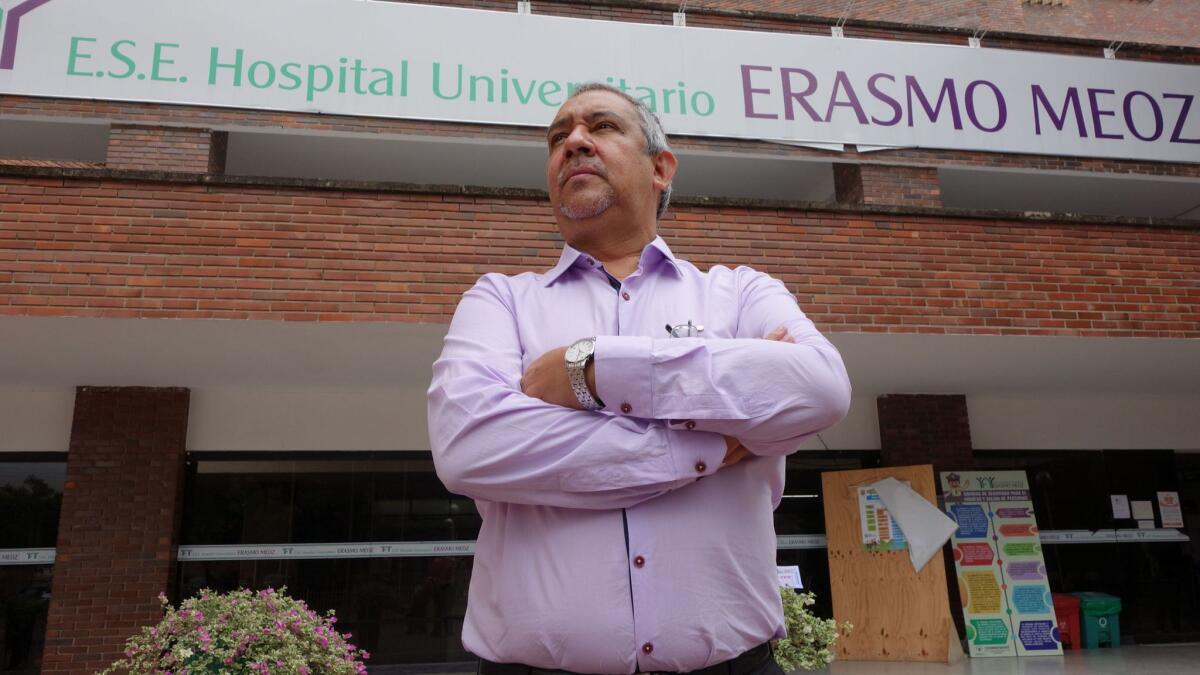
Manuel Antolinez, director of the International Committee of the Red Crossâ 240-bed shelter for Venezuelans near the border in Villa de Rosario, said he expects the crisis to get worse before easing.
âOur reading is that after the May 20 presidential election in Venezuela and the probable victory of President [Nicolas] Maduro, there will be increased dissatisfaction with the regime and more oppression against the opposition,â he said. âLiving conditions will worsen.â
Whatever its duration, the crisis is leading Ramirez, director of the Erasmo Meoz University Hospital, to stretch out payments to his suppliers from an average of 30 days to 90 days after billing. He hopes the government will come through with financial aid.
âThe collapse will happen when we canât pay our employees,â he said. He fears that could happen soon.
Kraul is a special correspondent.
More to Read
Sign up for Essential California
The most important California stories and recommendations in your inbox every morning.
You may occasionally receive promotional content from the Los Angeles Times.
